|
Dakota Revolvers - Italy’s first
Colt Clone
The
market for frontier gun reproductions formed in the
1950’s. Americans
were reliving their western past through television and
film. Post-war prosperity meant eager and abundant buyers for
replica firearms.
In
its Frontier revolver, Great Western Arms of California had a
compelling clone of the Peacemaker. But even with strong
demand, price competition drove them from the market by
1961. Mail order
houses like Navy Arms, Dixie Gun Works, and EMF were sourcing
their replica inventory from central Europe, where the economy
still lagged and manufacturing was cheap.
The
Peacemaker clone is now well established as the signature
piece of any serious replica vendor’s catalog. The first European
built reproduction of the Colt SAA was by JP Sauer of
Germany. Sturdy
and inexpensive, the Sauer clone single handedly destroyed the
price environment for the American made Great Western. Sold by several
US importers, Sauer and its replica would briefly have the
clone market to itself.
By
the early 1960’s, the gunsmiths and job shops of northern
Italy became very adept at supplying US replica
importers. The
business of reproduction firearms manufacture became
particularly successful and organized around Brescia. There, several family
shops thrived and grew into enduring, world class gun
makers. Uberti
and Pietta remain today. Armi San Marco,
Armi San Paolo, and Jager were very successful over the 70’s
and 80’s.
Armando
Piscetta and his Loano company Armi Jager started building
Peacemaker clones in 1962. A small importer,
Inter Continental Arms of Los Angeles, began selling it in the
US. Inter
Continental called it the “Dakota”.
Jager’s
early single action was significant as Italy’s first
Peacemaker clone.
More so, it was quite a bit better than the Sauer
revolver. It was
finished nice, functioned well, and still affordable. It established a
reputation for quality among the Italians. The makers around
Brescia would capture most replica manufacturing in a few
short years.
History of the
Jager Single Action
Early
on, the pattern for Piscetta’s Jager single action was
set. It was blue
and color case hardened with Italian hardwood grips. It had a brass grip
assembly, this with usually either more or less sweep than an
actual Colt. The
flamboyant brass straps are an easy to spot inauthentic touch,
but the Jager revolvers were nonetheless handsome and well
finished.
Inter
Continental Arms imported the Jager single action into the US
with some exclusivity through the 60’s. There are lesser
numbers of HEGE and Western Arms labeled Dakotas from those
years floating around.
For
the first several years, the Dakota didn’t have a maker’s
logo. Brescian
proof marks and a “Made in Italy” script were the only
indicators of origin.
In 1969 some of Inter Continental’s six-guns began
showing a Hammerli, Switzerland stamp. The nature of Inter
Continental’s supply chain in the 60’s is an esoteric point
that will remain lost to history. What can be
demonstrated is the Dakota was being built in two places for a
time: in Italy, by Jager, and in Switzerland, by
Hammerli.
Hammerli built Dakotas were numbered within the
existing Jager serial range, indicating an aligned if not
joint venture by the two companies to furnish the Dakota to
American importers.
Hammerli
already owned a stellar reputation for target pistols. New Hammerli built
six-guns made an immediate splash for attractiveness and
precise build. By
1972 Hammerli was signed by Interarms to make their Virginian
revolver.
Hammerli then ceased building the Dakota, leaving that
to Jager as before.
Demand
for the Dakota replica generally remained, though importers
came and went amid roiling 1970’s
economics. Inter
Continental ceased business in about 1975. EMF picked up the
Dakota trademark and became Jager’s highest volume importer.
The Dakota revolver
was also imported stateside in lesser numbers by Kassnar
and Navy Arms. These guns are the same, but go by “1873"
or "Frontier” model name. Odd models with “IGI”
and “Italguns” importer markings (Kansas model label
generally) are also Jager revolvers. By this time all
guns have “ARMI JAGER – ITALY” markings.
Sales
of the Jager pattern six-gun were robust for the next decade
but ultimately petered out. Cowboy action shooting
was established in the 80’s. As it grew, single
action shooters favored replicas with more authentic
appearance.
EMF dropped the Jager as its flagship
revolver in favor of models by Armi San Marco and Uberti, some
of which they labeled "New Dakota". Armi Jager stopped
building its Peacemaker clone in about 1993, and then soon
after exited firearms manufacturing
altogether.
Model
Variations
Besides
its basic color cased and blued model, Jager also did runs in
Sheriff, Bisley, Buntline, and Target model
configuration. A
catalog like this has become standard fare among replica
Peacemaker manufacturers, with those model labels being easy
to grasp without much explanation.
Note that Jager’s Buntline was an ambitiously detailed
reproduction. Some
had ladder sights, along with a finely rendered skeleton
stock.
Around
1980 EMF also briefly imported the Jager revolver as an
unfinished kit.
This was in effect a second take on the old Great
Western Arms kit guns (EMF having owned Great Western for a
time…). Jager
kits are called “Californian” models.
Inter
Continental Arms contracted with Jager for a modern, big-bore
hunting revolver to compete with Ruger’s Super Blackhawk. This model was, not
coincidentally, called the Super Dakota. It featured
target sights, an elongated grip assembly, and chambering in a
selection of modern performance calibers. These guns date from
1965 – 1970 or so.
They are high quality.
Jager
offered an engraved model to its distributors throughout
production years.
Examples will generally conform to one of two basic
patterns. Among
earlier production, frames are coin finished and engraved with
barrels blued.
Late production engraved guns are nickel plated. Some of these late
examples feature a cattlebrand pattern. In all cases,
engraving was etched or machine rolled.
A
US Army commemorative was built in the 1980’s. These are
cavalry style .45’s with 7 ½ inch barrels. 1000 is perhaps the
proper number to cite as built. They have their own
serial range.
Some but not all may have presentation
cases.
Caliber
selection was typically a standard fare of .22, .32-20, .357,
.38-40, .44-40, and .45.
Auxiliary cylinders could be purchased with several of
those chamberings to make for a convertible
revolver.
The
Dakota was at times available in .30 Carbine, one of a
very few production handguns offered in this
caliber.
The
Dakota could be had by special order in nickel finish. It was also
occasionally supplied with a steel grip
assembly.
Standard
grips were walnut or a European hardwood. Grips on earlier built
guns are much better looking, sometimes having an olivewood
appearance.
Dakotas
from 1962 – 1968 have no safety mechanism. Revolvers from 1969 –
71 or thereabouts generally have a hammer wheel safety. Revolvers after that
have a base pin safety. On Jagers,
this is an odd "twist" base pin rather than the “Swiss” two notch
pin that became common on Italian SAA
replicas.
Quality,
Collectability, and
Values
Italian
six-guns from the 70’s are to this day persistently described
as cheaply made and poorly built. This nugget stands as
conventional wisdom, passing to and fro among shooters when
they engage in casual conversations that broach the
topic.
This
piece of common knowledge was never really true, but it in any
event is by now broadly distorted. The spaghetti replicas
are quite good and have been from the start. They have always been
steel rather than alloy (…it was the German six-guns that had
a bit of alloy…).
Also, they had quite a bit more hand fit and finish
than was required to build them even at the time.
These
are traits of a high quality product, not junk. I was a child in the
70’s.
Understandably I did not have direct experience with
the revolvers then to form my own contemporaneous
anecdotes.
But I do recall the deep skepticism of foreign imports
and low prestige of mail order guns, at least in comparison to
say a “nice” Remington, SW, or Winchester. I’m inclined to say it
was these attitudes that were the origin of the Italian’s
“quality problem” rather than a definable pattern of defective
guns.
And
such it was with the Jager revolver. It’s a good gun. Exterior dimensions
are nominally larger than a Peacemaker. It’s more robust and
rendered of modern steel. A Jager is
without a doubt much stronger than a 1st generation
Colt, inasmuch as that is a useful
comparison.
Finish
quality was consistently good and often excellent. However, there were a
couple inauthentic touches that nagged the Jager SAA.
The
first was, as mentioned, the brass grip assembly. These are not
unattractive, although Jager never did properly mimic the
Colt’s grip outline.
More so, the brass itself was and is something of an
affront to SAA aficionados. Peacemakers simply are
not supposed to have brass grip straps. Clones with brass grip
straps have always faced an undercurrent of buyer
resistance.
Perhaps
the larger problem was the Jager’s assembly with metric screws
and parts sized to those metric screws. Maybe it ought
not mattered much for a gun that didn’t fail
very often.
But as cowboy shooting grew, buyers' demand for
authenticity became more strident. Jager nonetheless
declined to change its design. Ultimately its gun was
usurped in the marketplace by more “true-to-Colt” ASMs and
Ubertis.
Jager
serial numbering was strictly numerical and ascending,
ostensibly starting at 1. Examples from around
1990 have serials that approach 100,000. That number is subsequently a reasonable
estimate of total production over 30 years. Much of those guns are in
Europe, where Jager also did good business. There
they marketed blank firing sixguns in addition to centerfire and
.22.
There
is no defined collector base for the Jager revolver, and no
collectability premium built into current retail values. The proper ballpark for
price is utilitarian
rather than collectable, that of used cowboy action clones. Say $300, or
$350. They can be
had for a relative pittance on the classified and estate
markets.
Buntlines and engraved models attract common curio
seekers, and will go a bit higher.
Legacy
Armi
San Marco teetered and then failed in the early 2000’s for
reasons having nothing to do with the overall demand for
reproduction six-guns.
Uberti remained as the sole Italian clone maker, but they had just
been acquired by Beretta. Rather than expand to capture
ASM's market, Uberti's distribution was put under tighter corporate
discipline as production got directed into Beretta
sales networks.
Several
mail order houses relied on Italian six-guns to
anchor their catalogs, and they
faced diminished ability to fulfill orders. This was an obvious
void for another Brescian company to fill,
and it was Pietta that did. Having not
offered a Peacemaker clone before, they started by
getting Jager's old forging for the Dakota cylinder
frame. They updated the build with
modern CNC machining, and assembled finished guns
with Colt sized screws and parts. But the lineage of
Pietta’s modern rendered, authentically dimensioned six-gun actually goes back to the
original Dakota revolver by Jager.
“Dakota”
remains brilliantly evocative as a private label name for a
six-gun. EMF owns this trademark, and used it post- Jager on
revolvers by other makers. After contracting with Armi San
Marco and Uberti over the 1990’s for Peacemaker clones, EMF
began a long term relationship with Pietta in 2003. In its
premium finishes, Pietta’s clone has since served as EMF’s
flagship offering. This revolver is called the Great
Western II. In utilitarian finishes, and with a brass grip
assembly… this revolver is called the Dakota
II.
Make
and Build details
Company:
Armi Jager (Known late as Jager Adler). Hammerli marked
variant also 1969 – 1972.
Location:
Loano, Italy
Model:
Dakota, Frontier 1873, Nevada, Kansas,
Pioneer
Calibers:
.22, .30 Carbine, .32-20, .357 Magnum, .38-40, .41 Mag,
.44-40, .44 Mag, .45 Colt
Barrels: 4.75, 5.5
(most common), 7.5
Variants: Super
Dakota, Buntline, Sheriff, Target, Bisley, kit, engraved,
commemoratives
Finishes:
Blue & CCH, Nickel
Years MFG: 1962 –
1993
US Importers /
Other misc markings: Inter Continental Arms, HEGE,
EMF, Navy Arms,
Kassnar Harrisburg (KBI), Pacific Importers, Liberty Arms, IGI
Italguns
Copywrite Sack Peterson 2012
- reproductions should not be made without
permission.
Contact: sack@sackpeterson.com
A pair
of Inter Continental Arms imported
Dakota .22s made in 1967 and 1966
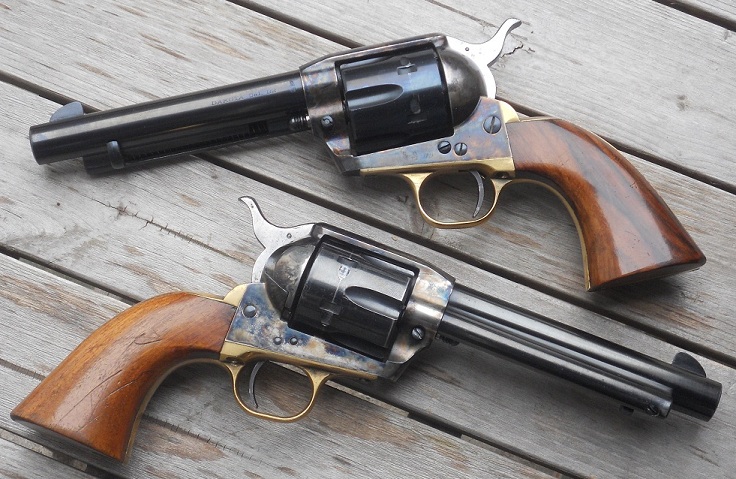
An EMF
Jager Dakota .22 made in 1984. This is a well made gun,
but does exhibit Jager's odd grip assembly. If it's not
entirely evident in the photo, you would sense it in
person.
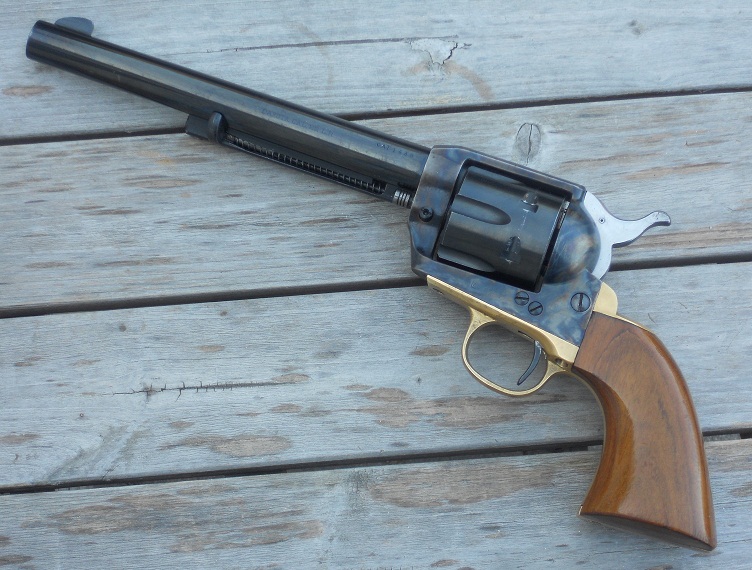
Dakotas, early 70's catalog for Inter Continental
Arms.
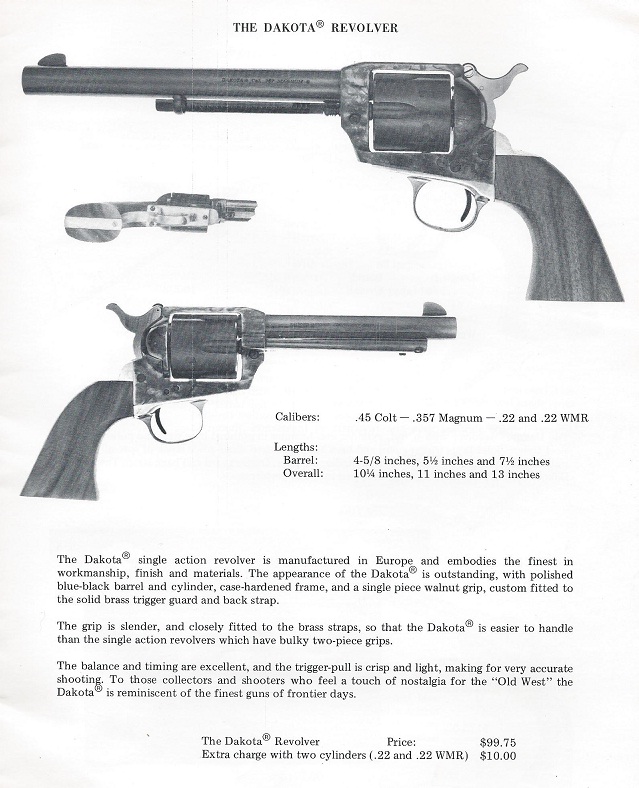
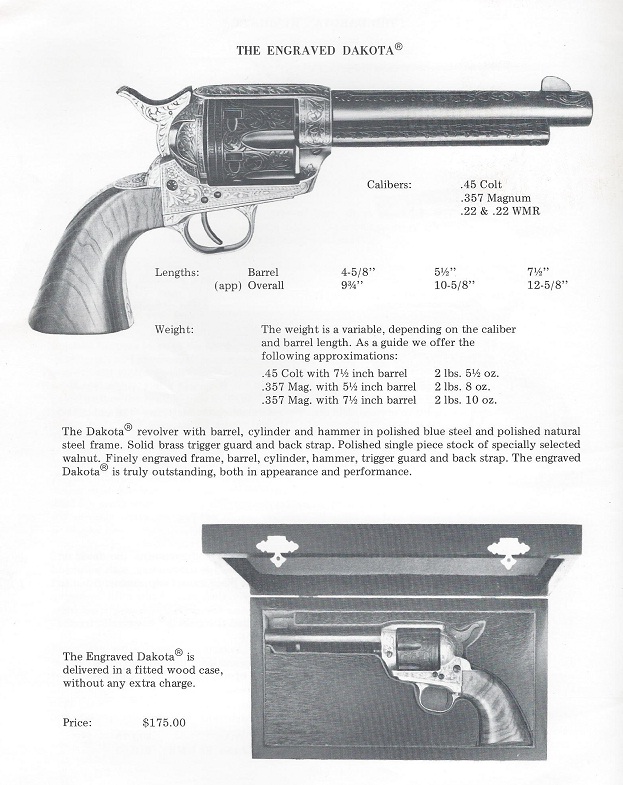

EMF's Dakota ad, about
1980. At the time, the 5 1/2 inch model was the
"Frontier", the 7 1/2 the "Cavalry", and the 4 3/4 the "Fast
Draw."
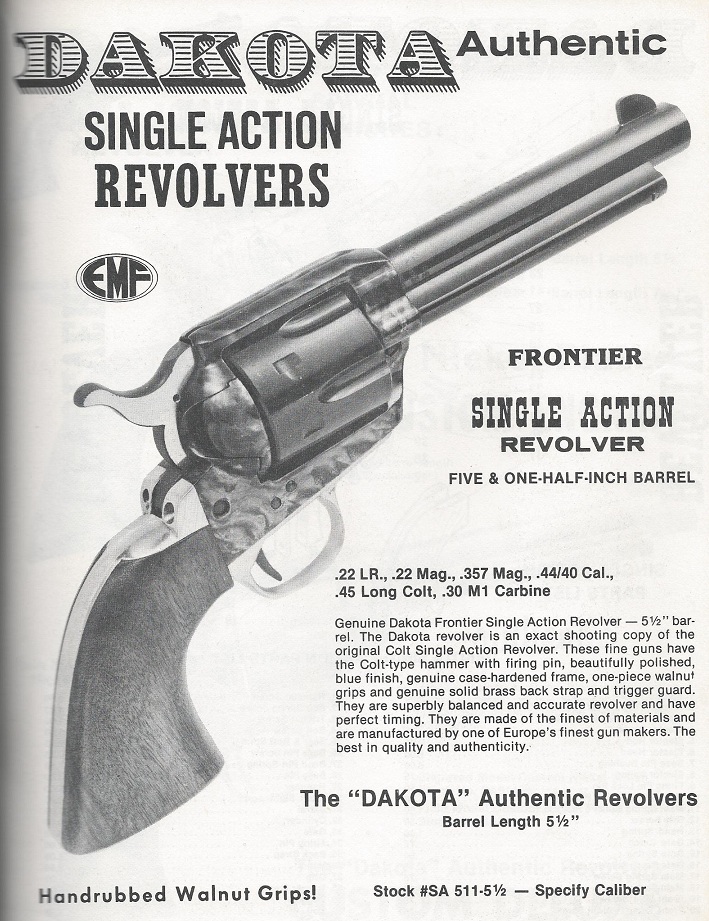
|